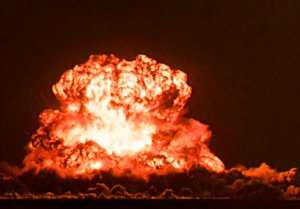Here’s another regurgitation whilst we feverishly type our fingers down to the nubs. This classic Damn Interesting article was originally published on 28 August 2007.
 China's first nuclear test, codename "596"In the closing weeks of 1964, the US Central Intelligence Agency was gripped by anxiety in the wake of troubling news. On October 16th, a great mushroom cloud had been spotted towering over the remote Chinese missile-testing range at Lop Nur. All evidence had indicated that Chinese scientists were at least a year away from squeezing the destructive secrets from the mighty atom, but this bombshell underscored the agency’s dangerously feeble espionage efforts in the Far East.
China's first nuclear test, codename "596"In the closing weeks of 1964, the US Central Intelligence Agency was gripped by anxiety in the wake of troubling news. On October 16th, a great mushroom cloud had been spotted towering over the remote Chinese missile-testing range at Lop Nur. All evidence had indicated that Chinese scientists were at least a year away from squeezing the destructive secrets from the mighty atom, but this bombshell underscored the agency’s dangerously feeble espionage efforts in the Far East.
Details regarding the twenty-two kiloton device were scarce, but the US regarded the development as an unwelcome wrinkle in the already precarious Cold War. Officials from India were also distressed, having felt the business end of China’s military during a recent border dispute. In the interest of self-preservation, the two nations made a secret pact to combine their China-watching efforts. Photo reconnaissance satellites were still too primitive for practical spying, and high-flying surveillance planes were too conspicuous, but there was one alternative vantage point. The intelligence agencies hatched a nefarious scheme to keep a sharp eye on China’s weapons tests from atop India’s
Nanda Devi, one of the tallest mountains of the imposing Himalayan mountain range. It offered an unobstructed view of China’s distant test site, assuming one could manage to hoist a sufficiently powerful electronic eye to its summit.
 China's first nuclear test, codename "596"In the closing weeks of 1964, the US Central Intelligence Agency was gripped by anxiety in the wake of troubling news. On October 16th, a great mushroom cloud had been spotted towering over the remote Chinese missile-testing range at Lop Nur. All evidence had indicated that Chinese scientists were at least a year away from squeezing the destructive secrets from the mighty atom, but this bombshell underscored the agency’s dangerously feeble espionage efforts in the Far East.
China's first nuclear test, codename "596"In the closing weeks of 1964, the US Central Intelligence Agency was gripped by anxiety in the wake of troubling news. On October 16th, a great mushroom cloud had been spotted towering over the remote Chinese missile-testing range at Lop Nur. All evidence had indicated that Chinese scientists were at least a year away from squeezing the destructive secrets from the mighty atom, but this bombshell underscored the agency’s dangerously feeble espionage efforts in the Far East.
No comments:
Post a Comment